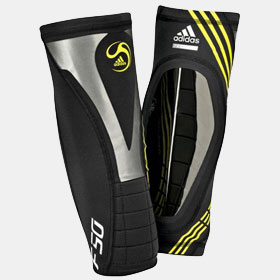
Soccer shin guards....what good are they?
For one thing, soccer shin guards are required as part of the FIFA Laws of the Game.
If your like me, you probably value your legs, and have grown somewhat fond of them.
If that's not reason enough though, keep this in mind:
The tibia is the bone that runs from your knee to your ankle and lies underneath your shin. Unfortunately for us humans, it's extremely exposed and has little natural protection. If you've ever been hit there, even accidentally, you'll know that it's a particularly excruciating type of pain.
The solution? Properly fitted shin guards will help reduce your risk of injury. It'll also improve your game. If you constantly fear injury, your play is going to suffer.
What are they made of?
Soccer shin guards come in a few different materials. Cheapest are foam guards. While light, they don't provide much protection, but are suitable for players who value mobility over safety. Also inexpensive are plastic guards. While reasonably priced, these guards provide less impact protection than the alternatives. The more expensive guards are made with polyurethane or polypropylene. These synthetic materials offer superior impact protection, form fit to the shin, and are very lightweight. Keep in mind that while they are more expensive, a decent pair can still run you less than $30.
What am I looking for in a shin guard?
 First of all, consider the position you play.
First of all, consider the position you play.As either a forward or keeper, lighter guards are ideal due to both the speed requirements of the positions and there generally being less physical contact. Bulky guards can slow you down, so you may want to keep this in mind. Defensemen will find themselves in much more physical play and therefore, a much heavier guard would be ideal. Midfielders, depending on their particular playing style can go with either, however, a heavier guard would be suitable due to the intense physical nature of the position. Really it depends on how bothered you are by the guard and how much it restricts your mobility. Most soccer shin guards now come with both ankle and Achilles protection and while some find this restrictive, I personally think the extra padding is brilliant as these exposed areas are very easy to injure. Some of the newer shin guards are placed in compression sleeves like the ones pictures above. These guards are wrapped around the calf which helps promote blood flow and much like compression shorts prevent cramping.
What about fit?
The guard should fit the whole length of the shin, from an inch or two below the knee to down just above the ankle. Some more advanced players choose guards that are quite a bit shorter than that as they claim it provides greater ball feel; this is really something you would have to try for yourself and determine if the trade off is worth it. Though it may seem obvious, try the guard on with proper soccer socks and make sure you run around in whatever pair you try ensuring you have no difficulty with your stride. Depending on the style you choose, a finger should fit between your guard and your leg to allow circulation, so make sure they're not too tight. This obviously doesn't apply if you're choosing a guard with compression sleeve.
Return from Soccer Shin Guards to Gear
|











